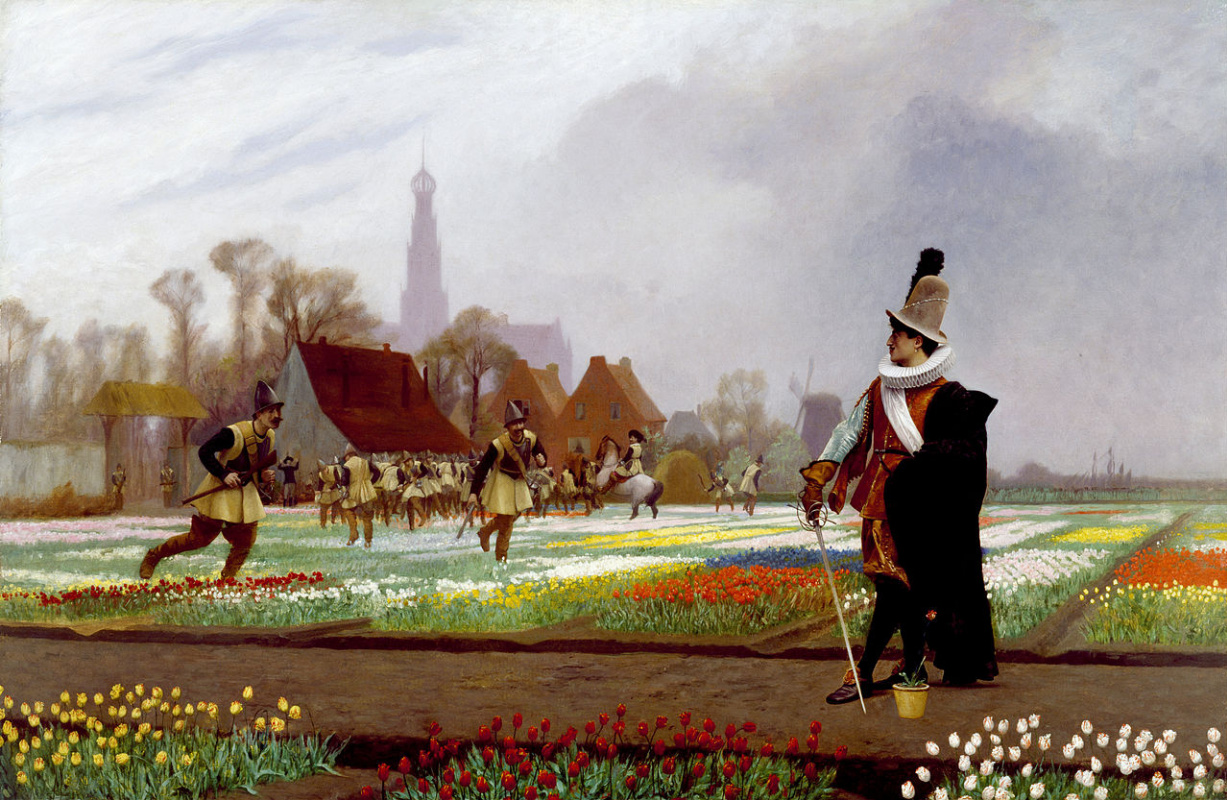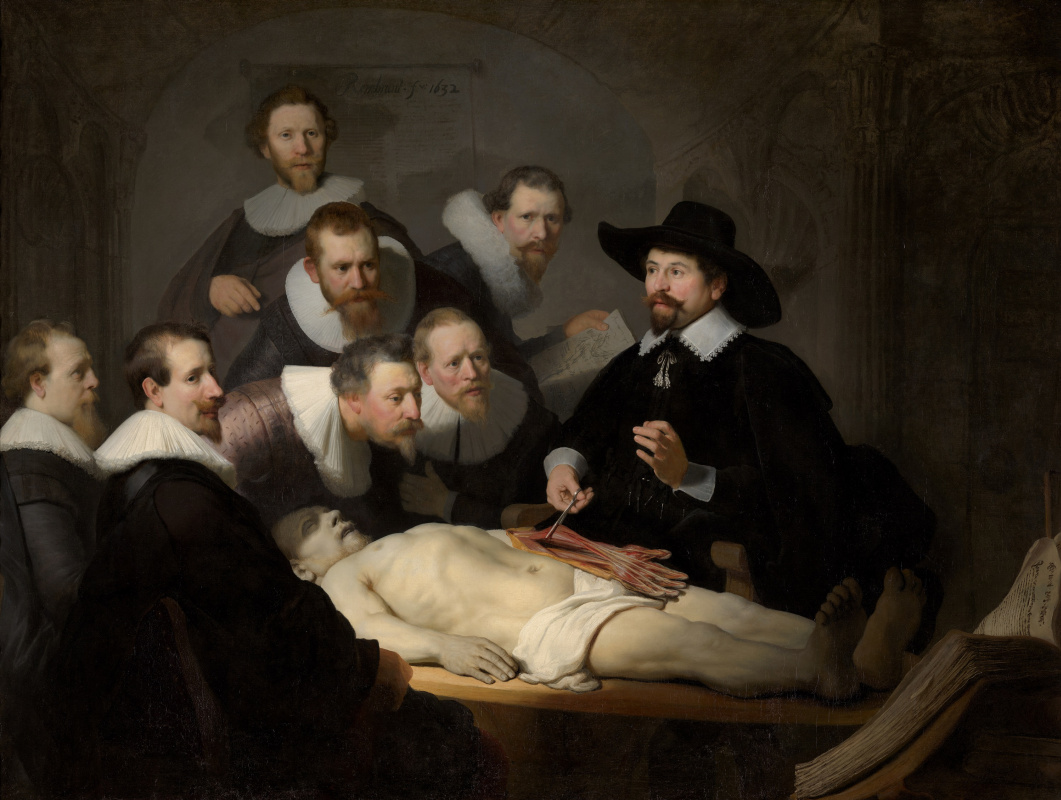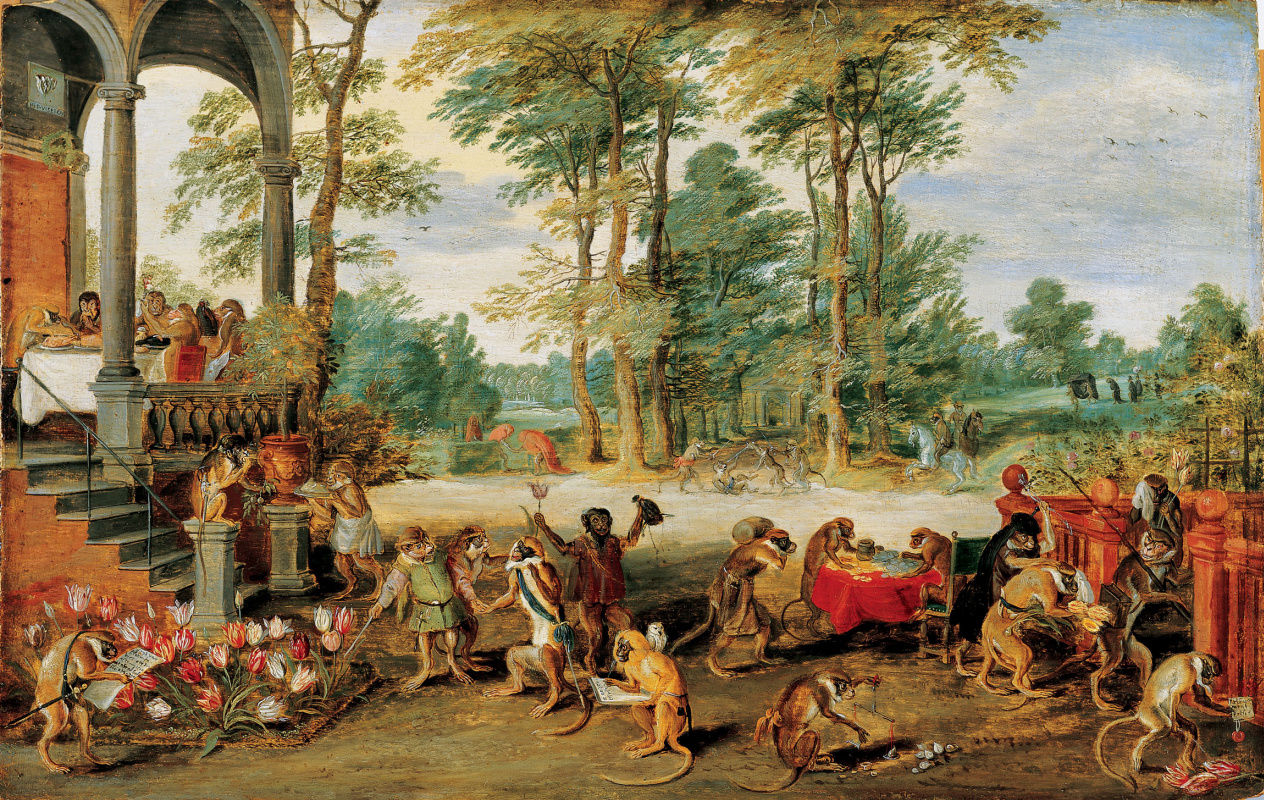Arthive is trying to figure out what is happening in the paintings, in which God knows what seems to be going on

A pearl-gray dawn. It’s cool and seems to be drizzling. Pale silhouettes of urban buildings in the distance are blurred and weightless. The mill and the bell tower seem to float in the humid sea air. On the horizon, masts and sails can hardly be seen. Their shaky outline stands in stark contrast with the colorful patchwork of tulip flower beds.
The cloudy melancholy of the early morning was trampled on by the soldiers' boots. The perimeter is cordoned off and there are sentries at the gates. A man in civilian clothes — must be the owner of the estate, froze with his hands up. The guards are busy rushing through the flower beds and passionately trampling flowers, clubbing them with rifle butts. The commanding officer rode to the field on horseback, it must be, for greater efficiency.
In the foreground is a dandy aristocrat with a mustache and a sword. In his ear shone an earring, and in his eyes — a determination. Having unsheathed his blade, he protects the pot with the tulip from soldiers rushing towards it. Dignity of bearing, sharply defined cheekbones, a hand, tightly gripping the hilt — his looks seem to declare: "This pot is mine!"
So what’s going on here? Did a costume party, prolonged until the morning, go out of control? Does the progressive public protest against the sexist tradition of giving women flowers? Is Uwe Boll shooting the prequel to The Day of the Triffids? Or is it the medieval DEA looking for psilocybin mushrooms among the tulips? Then what in the world caused such a vivid interest of the mustachioed protohipster to an ordinary flower pot?
In order to find the answers, we’ll have to drill down deep. Certainly deeper than it takes to dig a tulip bulb.
The first tulips appeared in Western Europe in the middle of the XVI century. Imported from Iran and the Ottoman Empire , they quickly became the favourite flowers of the European nobility. The first tulip, known in Western European history, flourished in 1559 in Bavaria. And the center of the tulip industry in those years was France. It was there that at the beginning of the XVII century the first feverish price rise of tulips was recorded — people gave away their mills, estates and fortunes in order to buy bulbs which were considered an enviable dowry; tulips were an attribute of luxury and served as a social marker. However, in France, the "tulip mania" was short lived and had a rather episodic nature. The real tulip Armageddon broke out in the Netherlands.
Perhaps a crucial role in the fact that today Holland is strongly associated in the public mind with tulips, was played by one single person — a native of France Carolus Clusius. A humanist, polyglot, the chief botanist of his time and a passionate fan of tulips, he enjoyed great authority. The works and experiments of Clusius provoked fashion for tulips among European monarchs and aristocrats. In 1593 Clusius was appointed honorary professor of botany at the University of Leiden and moved to Holland, where he continued to observe and describe the mysterious phenomenon.
From time to time, ordinary monochrome tulips regenerated, producing offspring with variegated petals. Attempts to bring out the variegated tulips artificially invariably ended in failure — even Carolus Clusius couldn’t solve this beautiful mystery.
The cloudy melancholy of the early morning was trampled on by the soldiers' boots. The perimeter is cordoned off and there are sentries at the gates. A man in civilian clothes — must be the owner of the estate, froze with his hands up. The guards are busy rushing through the flower beds and passionately trampling flowers, clubbing them with rifle butts. The commanding officer rode to the field on horseback, it must be, for greater efficiency.
In the foreground is a dandy aristocrat with a mustache and a sword. In his ear shone an earring, and in his eyes — a determination. Having unsheathed his blade, he protects the pot with the tulip from soldiers rushing towards it. Dignity of bearing, sharply defined cheekbones, a hand, tightly gripping the hilt — his looks seem to declare: "This pot is mine!"
So what’s going on here? Did a costume party, prolonged until the morning, go out of control? Does the progressive public protest against the sexist tradition of giving women flowers? Is Uwe Boll shooting the prequel to The Day of the Triffids? Or is it the medieval DEA looking for psilocybin mushrooms among the tulips? Then what in the world caused such a vivid interest of the mustachioed protohipster to an ordinary flower pot?
In order to find the answers, we’ll have to drill down deep. Certainly deeper than it takes to dig a tulip bulb.
The first tulips appeared in Western Europe in the middle of the XVI century. Imported from Iran and the Ottoman Empire , they quickly became the favourite flowers of the European nobility. The first tulip, known in Western European history, flourished in 1559 in Bavaria. And the center of the tulip industry in those years was France. It was there that at the beginning of the XVII century the first feverish price rise of tulips was recorded — people gave away their mills, estates and fortunes in order to buy bulbs which were considered an enviable dowry; tulips were an attribute of luxury and served as a social marker. However, in France, the "tulip mania" was short lived and had a rather episodic nature. The real tulip Armageddon broke out in the Netherlands.
Perhaps a crucial role in the fact that today Holland is strongly associated in the public mind with tulips, was played by one single person — a native of France Carolus Clusius. A humanist, polyglot, the chief botanist of his time and a passionate fan of tulips, he enjoyed great authority. The works and experiments of Clusius provoked fashion for tulips among European monarchs and aristocrats. In 1593 Clusius was appointed honorary professor of botany at the University of Leiden and moved to Holland, where he continued to observe and describe the mysterious phenomenon.
From time to time, ordinary monochrome tulips regenerated, producing offspring with variegated petals. Attempts to bring out the variegated tulips artificially invariably ended in failure — even Carolus Clusius couldn’t solve this beautiful mystery.

The Portrait of Carolus Clusius. Attributed to Jacob de Monte, 1585.
The bizarre pattern was a consequence of the virus — such flowers were weak, and therefore extremely rare. Of course, they were in great demand and cost an arm and a leg. Only in the XX century it was experimentally proved that the virus was transmitted with the juice of diseased plants. Contemporaries of Clusius had to plant vast territories with ordinary tulips (or breeders), hoping that one onion of hundreds would magically regenerate.
It was a gamble, something like a national lottery. Following the gardeners-enthusiasts (initially quite enlightened and wealthy audience), commoners began to join the game. Everyone having a piece of land and a couple of cheap bulbs could hit the jackpot.
The variegated tulips began to be awarded "high-profile titles". On the market there appeared "admirals" and "generals", followed by "generalissimos", "admirals' admirals", etc.
In the 1620s, the price of one such bulb reached an average of 1,000 guilders — this was equivalent to almost a kilogram of gold. The annual income of a skilled artisan was 300 guilders. The agiotage increased rapidly. By the 30th, the general fascination with tulips reminded the epidemic, as evidenced by many historical anecdotes.
For example, the Scottish journalist Charles Mackay, who lived in the XIX century, in his book "Extraordinary Popular Delusions and the Madness of Crowds" wrote such a tragicomic story. A certain sailor went to the office of a wealthy merchant to inform him about the arrival of a valuable cargo at the port. The merchant generously rewarded the messenger, giving him a smoked herring. Together with the herring the simple-minded sailor took from the office the onion bulb (so he thought). And was thrown into prison: the poor man ate a priceless tulip bulb of Semper Augustus, costing thousands of guilders.
A well-known surgeon and mayor of Amsterdam Claes Pieterszoon not only decorated his family coat of arms with tulips but also took the "tulip" name — he entered the history of medicine as Dr. Nicolaes Tulp.
It was a gamble, something like a national lottery. Following the gardeners-enthusiasts (initially quite enlightened and wealthy audience), commoners began to join the game. Everyone having a piece of land and a couple of cheap bulbs could hit the jackpot.
The variegated tulips began to be awarded "high-profile titles". On the market there appeared "admirals" and "generals", followed by "generalissimos", "admirals' admirals", etc.
In the 1620s, the price of one such bulb reached an average of 1,000 guilders — this was equivalent to almost a kilogram of gold. The annual income of a skilled artisan was 300 guilders. The agiotage increased rapidly. By the 30th, the general fascination with tulips reminded the epidemic, as evidenced by many historical anecdotes.
For example, the Scottish journalist Charles Mackay, who lived in the XIX century, in his book "Extraordinary Popular Delusions and the Madness of Crowds" wrote such a tragicomic story. A certain sailor went to the office of a wealthy merchant to inform him about the arrival of a valuable cargo at the port. The merchant generously rewarded the messenger, giving him a smoked herring. Together with the herring the simple-minded sailor took from the office the onion bulb (so he thought). And was thrown into prison: the poor man ate a priceless tulip bulb of Semper Augustus, costing thousands of guilders.
A well-known surgeon and mayor of Amsterdam Claes Pieterszoon not only decorated his family coat of arms with tulips but also took the "tulip" name — he entered the history of medicine as Dr. Nicolaes Tulp.
The Anatomy Lesson of Dr Nicolaes Tulp
1632, 169.5×216.5 cm
According to Mackay, "Nobles, citizens, farmers, mechanics, seamen, footmen, maidservants, even chimney-sweeps and old clotheswomen, dabbled in tulips… In 1634, the rage among the Dutch to possess them was so great that the ordinary industry of the country was neglected, and the population, even to its lowest dregs, embarked in the tulip trade."
In 1635, the speculation of "cash" bulbs was almost completely replaced by "air trade". For the most part, bulbs remained in the ground, and only the obligations to dig them, for example, in the coming summer, were sold and resold. In the 37th the market collapsed with a crash. According to a popular version, the Golden Age of the Netherlands ended in a financial crisis. The "tulip mania" is known as the first stock bubble in the history of modern times.
This interesting episode from the history of the Dutch economy was depicted by French painter Jean-Léon Gérôme.
Some modern economists believe that the devastating consequences of the "tulip fever" is just a legend. In their opinion, "tulip mania" was not as widespread as it was presented by Charles Mackay. It’s true that someone went bankrupt, someone made a fortune, but the Dutch economy as a whole did not experience a serious shock. The myth of nationwide tulip madness was spread by the clergy and moralists, as a criticism of gullibility and greed.
In 1635, the speculation of "cash" bulbs was almost completely replaced by "air trade". For the most part, bulbs remained in the ground, and only the obligations to dig them, for example, in the coming summer, were sold and resold. In the 37th the market collapsed with a crash. According to a popular version, the Golden Age of the Netherlands ended in a financial crisis. The "tulip mania" is known as the first stock bubble in the history of modern times.
This interesting episode from the history of the Dutch economy was depicted by French painter Jean-Léon Gérôme.
Some modern economists believe that the devastating consequences of the "tulip fever" is just a legend. In their opinion, "tulip mania" was not as widespread as it was presented by Charles Mackay. It’s true that someone went bankrupt, someone made a fortune, but the Dutch economy as a whole did not experience a serious shock. The myth of nationwide tulip madness was spread by the clergy and moralists, as a criticism of gullibility and greed.
Allegory of Tulipmania
1640-th
, 31×49 cm
As for Gérôme, he interprets the above events without moralizing. The motives of his characters are quite prosaic, and their actions are rational. Guardsmen are trampling tulips-breeders, thus, "regulating the market". The aristocrat with a sword protects a valuable flower — judging by the mottled red and white petals, it is Semper Augustus.
In the 80s of the XIX century, when this painting was created, Jean-Léon Gérôme was criticized a lot for his stagnancy and obsessive adherence to academicism, as well as for the lack of "other bottom" in his paintings. In this sense, The Tulip Folly is a typical work of this period. For Gérôme this was just a historical episode — not too dramatic and not too instructive. A wise man, he understood that the history, endlessly repeating itself, does not teach anyone anything.
A hundred years after the "tulip mania" in Holland began a "hyacinth mania". In France there were dahlias. In China — lilies. In America — "black Thursday" and the mortgage crisis, in Russia — Sergei Mavrodi.
In 2013, Nout Wellink, former president of the Dutch Central Bank, compared the "tulip mania" with the current cryptocurrency boom. "This is worse than the tulip mania…" he said of bitcoin. "At least you got a tulip."
Andrii Zymohliadov.
A hundred years after the "tulip mania" in Holland began a "hyacinth mania". In France there were dahlias. In China — lilies. In America — "black Thursday" and the mortgage crisis, in Russia — Sergei Mavrodi.
In 2013, Nout Wellink, former president of the Dutch Central Bank, compared the "tulip mania" with the current cryptocurrency boom. "This is worse than the tulip mania…" he said of bitcoin. "At least you got a tulip."
Andrii Zymohliadov.




















